Metro Bank Performance: Analysis of Financial Statements and Ratios
VerifiedAdded on 2023/01/12
|14
|4045
|92
Report
AI Summary
This report provides a comprehensive financial analysis of Metro Bank, examining its performance over a nine-year period. It begins with an overview of the bank's nature and business activities, followed by a critical analysis of changes in its income statement and balance sheet. The report assesses the bank's financial performance using key ratios such as profitability, efficiency, asset quality, and capital adequacy. It also evaluates the impact of changes in the banking sector, including regulations, FinTech developments, and consolidation, on Metro Bank's performance. The analysis includes income trends, balance sheet trends, and a debt-equity graph, providing a detailed understanding of the bank's financial position. Furthermore, the report analyzes various financial ratios, including gross profit margin, net profit margin, asset turnover ratio, fixed asset turnover ratio, asset quality ratios, and capital adequacy ratios, to assess the bank's efficiency and financial health. The report concludes with an assessment of the expected future performance of Metro Bank.
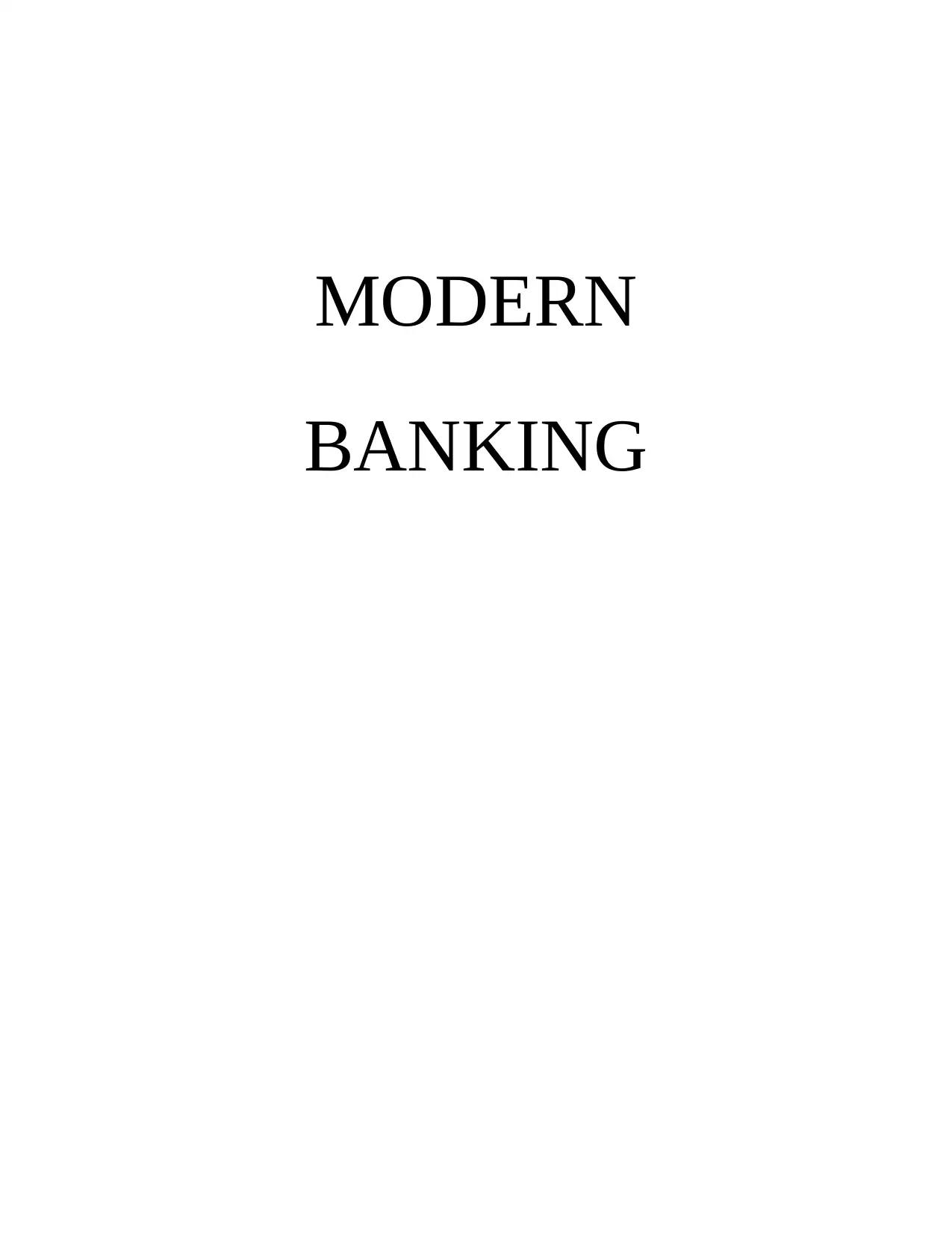
MODERN
BANKING
BANKING
Paraphrase This Document
Need a fresh take? Get an instant paraphrase of this document with our AI Paraphraser
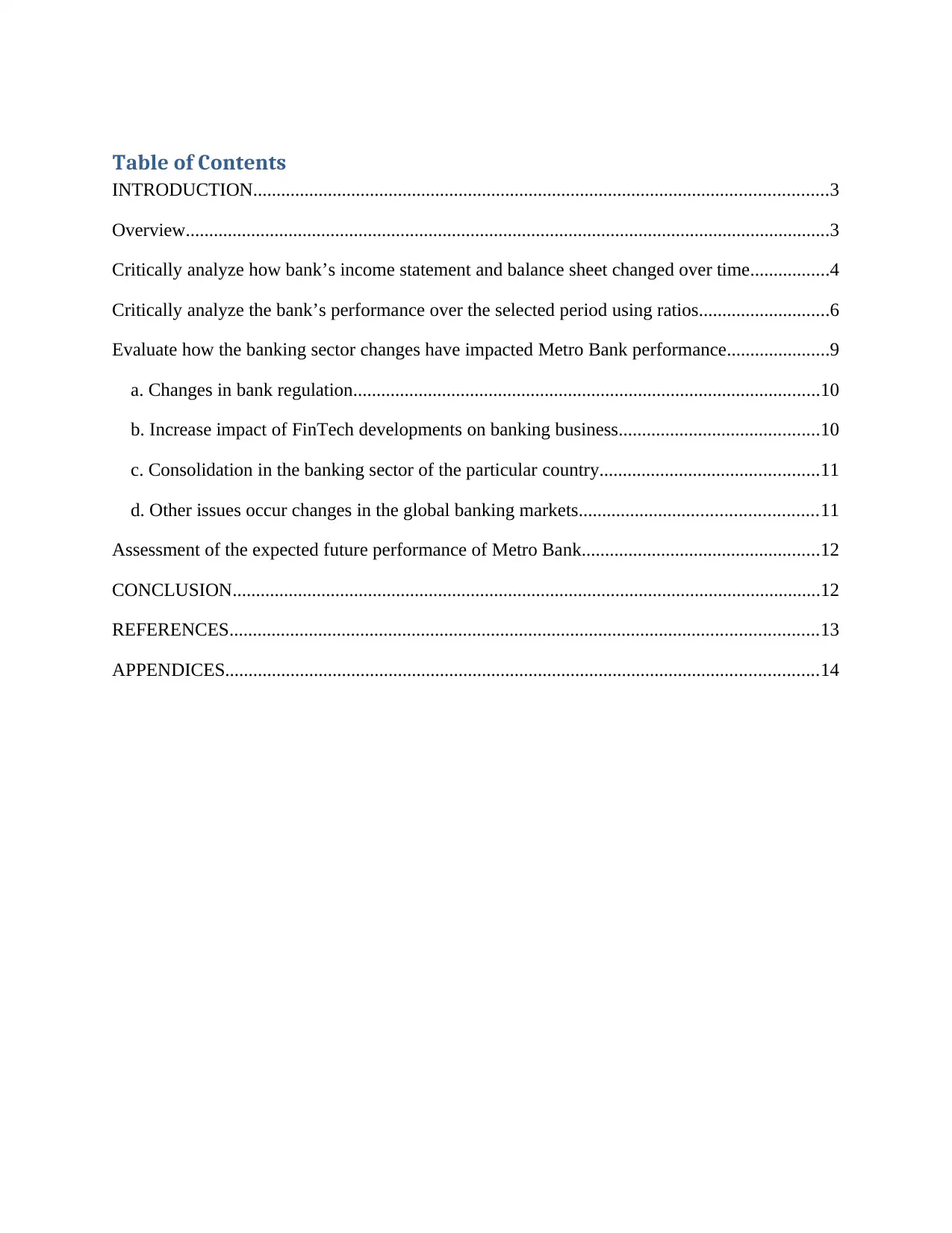
Table of Contents
INTRODUCTION...........................................................................................................................3
Overview..........................................................................................................................................3
Critically analyze how bank’s income statement and balance sheet changed over time.................4
Critically analyze the bank’s performance over the selected period using ratios............................6
Evaluate how the banking sector changes have impacted Metro Bank performance......................9
a. Changes in bank regulation....................................................................................................10
b. Increase impact of FinTech developments on banking business...........................................10
c. Consolidation in the banking sector of the particular country...............................................11
d. Other issues occur changes in the global banking markets...................................................11
Assessment of the expected future performance of Metro Bank...................................................12
CONCLUSION..............................................................................................................................12
REFERENCES..............................................................................................................................13
APPENDICES...............................................................................................................................14
INTRODUCTION...........................................................................................................................3
Overview..........................................................................................................................................3
Critically analyze how bank’s income statement and balance sheet changed over time.................4
Critically analyze the bank’s performance over the selected period using ratios............................6
Evaluate how the banking sector changes have impacted Metro Bank performance......................9
a. Changes in bank regulation....................................................................................................10
b. Increase impact of FinTech developments on banking business...........................................10
c. Consolidation in the banking sector of the particular country...............................................11
d. Other issues occur changes in the global banking markets...................................................11
Assessment of the expected future performance of Metro Bank...................................................12
CONCLUSION..............................................................................................................................12
REFERENCES..............................................................................................................................13
APPENDICES...............................................................................................................................14
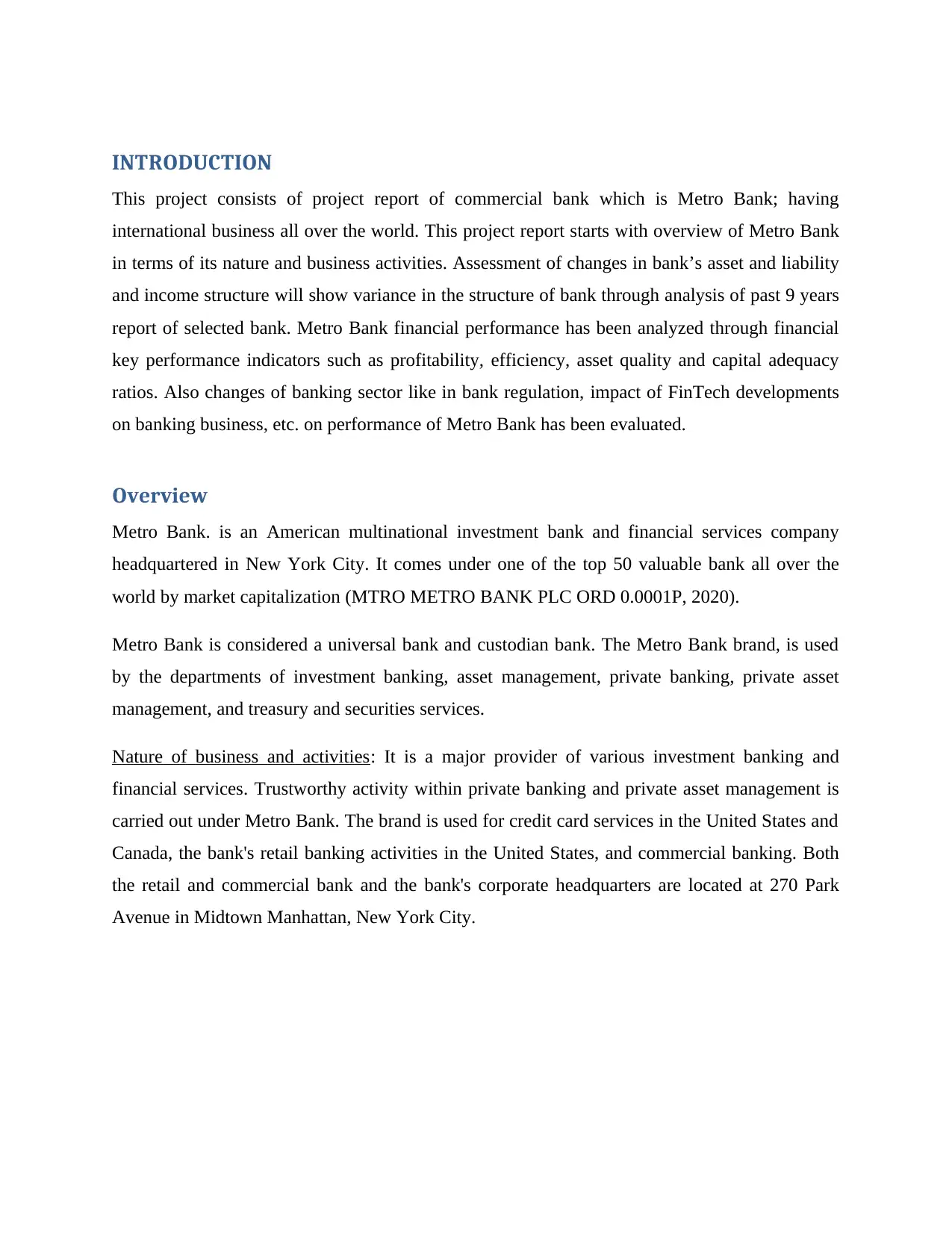
INTRODUCTION
This project consists of project report of commercial bank which is Metro Bank; having
international business all over the world. This project report starts with overview of Metro Bank
in terms of its nature and business activities. Assessment of changes in bank’s asset and liability
and income structure will show variance in the structure of bank through analysis of past 9 years
report of selected bank. Metro Bank financial performance has been analyzed through financial
key performance indicators such as profitability, efficiency, asset quality and capital adequacy
ratios. Also changes of banking sector like in bank regulation, impact of FinTech developments
on banking business, etc. on performance of Metro Bank has been evaluated.
Overview
Metro Bank. is an American multinational investment bank and financial services company
headquartered in New York City. It comes under one of the top 50 valuable bank all over the
world by market capitalization (MTRO METRO BANK PLC ORD 0.0001P, 2020).
Metro Bank is considered a universal bank and custodian bank. The Metro Bank brand, is used
by the departments of investment banking, asset management, private banking, private asset
management, and treasury and securities services.
Nature of business and activities: It is a major provider of various investment banking and
financial services. Trustworthy activity within private banking and private asset management is
carried out under Metro Bank. The brand is used for credit card services in the United States and
Canada, the bank's retail banking activities in the United States, and commercial banking. Both
the retail and commercial bank and the bank's corporate headquarters are located at 270 Park
Avenue in Midtown Manhattan, New York City.
This project consists of project report of commercial bank which is Metro Bank; having
international business all over the world. This project report starts with overview of Metro Bank
in terms of its nature and business activities. Assessment of changes in bank’s asset and liability
and income structure will show variance in the structure of bank through analysis of past 9 years
report of selected bank. Metro Bank financial performance has been analyzed through financial
key performance indicators such as profitability, efficiency, asset quality and capital adequacy
ratios. Also changes of banking sector like in bank regulation, impact of FinTech developments
on banking business, etc. on performance of Metro Bank has been evaluated.
Overview
Metro Bank. is an American multinational investment bank and financial services company
headquartered in New York City. It comes under one of the top 50 valuable bank all over the
world by market capitalization (MTRO METRO BANK PLC ORD 0.0001P, 2020).
Metro Bank is considered a universal bank and custodian bank. The Metro Bank brand, is used
by the departments of investment banking, asset management, private banking, private asset
management, and treasury and securities services.
Nature of business and activities: It is a major provider of various investment banking and
financial services. Trustworthy activity within private banking and private asset management is
carried out under Metro Bank. The brand is used for credit card services in the United States and
Canada, the bank's retail banking activities in the United States, and commercial banking. Both
the retail and commercial bank and the bank's corporate headquarters are located at 270 Park
Avenue in Midtown Manhattan, New York City.
⊘ This is a preview!⊘
Do you want full access?
Subscribe today to unlock all pages.

Trusted by 1+ million students worldwide
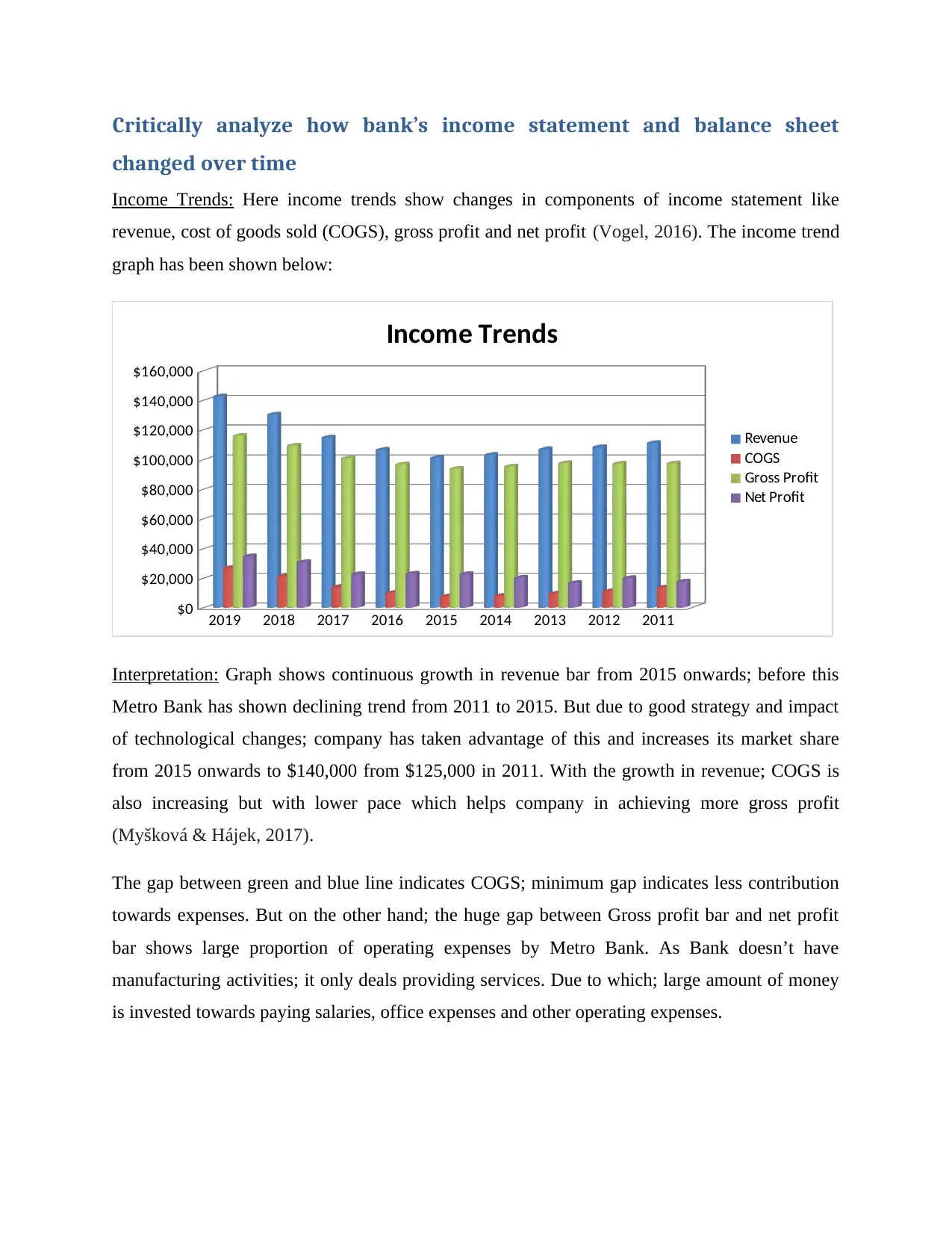
Critically analyze how bank’s income statement and balance sheet
changed over time
Income Trends: Here income trends show changes in components of income statement like
revenue, cost of goods sold (COGS), gross profit and net profit (Vogel, 2016). The income trend
graph has been shown below:
2019 2018 2017 2016 2015 2014 2013 2012 2011
$0
$20,000
$40,000
$60,000
$80,000
$100,000
$120,000
$140,000
$160,000
Income Trends
Revenue
COGS
Gross Profit
Net Profit
Interpretation: Graph shows continuous growth in revenue bar from 2015 onwards; before this
Metro Bank has shown declining trend from 2011 to 2015. But due to good strategy and impact
of technological changes; company has taken advantage of this and increases its market share
from 2015 onwards to $140,000 from $125,000 in 2011. With the growth in revenue; COGS is
also increasing but with lower pace which helps company in achieving more gross profit
(Myšková & Hájek, 2017).
The gap between green and blue line indicates COGS; minimum gap indicates less contribution
towards expenses. But on the other hand; the huge gap between Gross profit bar and net profit
bar shows large proportion of operating expenses by Metro Bank. As Bank doesn’t have
manufacturing activities; it only deals providing services. Due to which; large amount of money
is invested towards paying salaries, office expenses and other operating expenses.
changed over time
Income Trends: Here income trends show changes in components of income statement like
revenue, cost of goods sold (COGS), gross profit and net profit (Vogel, 2016). The income trend
graph has been shown below:
2019 2018 2017 2016 2015 2014 2013 2012 2011
$0
$20,000
$40,000
$60,000
$80,000
$100,000
$120,000
$140,000
$160,000
Income Trends
Revenue
COGS
Gross Profit
Net Profit
Interpretation: Graph shows continuous growth in revenue bar from 2015 onwards; before this
Metro Bank has shown declining trend from 2011 to 2015. But due to good strategy and impact
of technological changes; company has taken advantage of this and increases its market share
from 2015 onwards to $140,000 from $125,000 in 2011. With the growth in revenue; COGS is
also increasing but with lower pace which helps company in achieving more gross profit
(Myšková & Hájek, 2017).
The gap between green and blue line indicates COGS; minimum gap indicates less contribution
towards expenses. But on the other hand; the huge gap between Gross profit bar and net profit
bar shows large proportion of operating expenses by Metro Bank. As Bank doesn’t have
manufacturing activities; it only deals providing services. Due to which; large amount of money
is invested towards paying salaries, office expenses and other operating expenses.
Paraphrase This Document
Need a fresh take? Get an instant paraphrase of this document with our AI Paraphraser

Balance sheet trend: Balance sheet shows the financial position of a company. Metro Bank’s
balance sheet will reveal how much assets and liabilities have been maintained by the company.
Below is the trend graph of total assets, total liabilities, current assets and current liabilities:
2019 2018 2017 2016 2015 2014 2013 2012 2011
$0
$500,000
$1,000,000
$1,500,000
$2,000,000
$2,500,000
$3,000,000
Assets
Liabilities
Current Liabilities
Current Assets
Interpretation: From the above graph; it can be concluded that there’s fluctuations in the growth
of assets from 2011; in other words asset growth is not consistent and bars shows many uptowns
since 2011. But from 2015 onwards; company’s total assets have been increased with minor
growth rate. On the other hand; same growth rate can be seen in the case of total liabilities, and
current liabilities; except current assets, which has declined in 2019. Metro Bank’s current
liabilities are always greater than current assets; except in 2015, 2016, 2017 and 2018 where
current assets are greater than equals to current liabilities (Schroeder, Clark & Cathey, 2019).
balance sheet will reveal how much assets and liabilities have been maintained by the company.
Below is the trend graph of total assets, total liabilities, current assets and current liabilities:
2019 2018 2017 2016 2015 2014 2013 2012 2011
$0
$500,000
$1,000,000
$1,500,000
$2,000,000
$2,500,000
$3,000,000
Assets
Liabilities
Current Liabilities
Current Assets
Interpretation: From the above graph; it can be concluded that there’s fluctuations in the growth
of assets from 2011; in other words asset growth is not consistent and bars shows many uptowns
since 2011. But from 2015 onwards; company’s total assets have been increased with minor
growth rate. On the other hand; same growth rate can be seen in the case of total liabilities, and
current liabilities; except current assets, which has declined in 2019. Metro Bank’s current
liabilities are always greater than current assets; except in 2015, 2016, 2017 and 2018 where
current assets are greater than equals to current liabilities (Schroeder, Clark & Cathey, 2019).
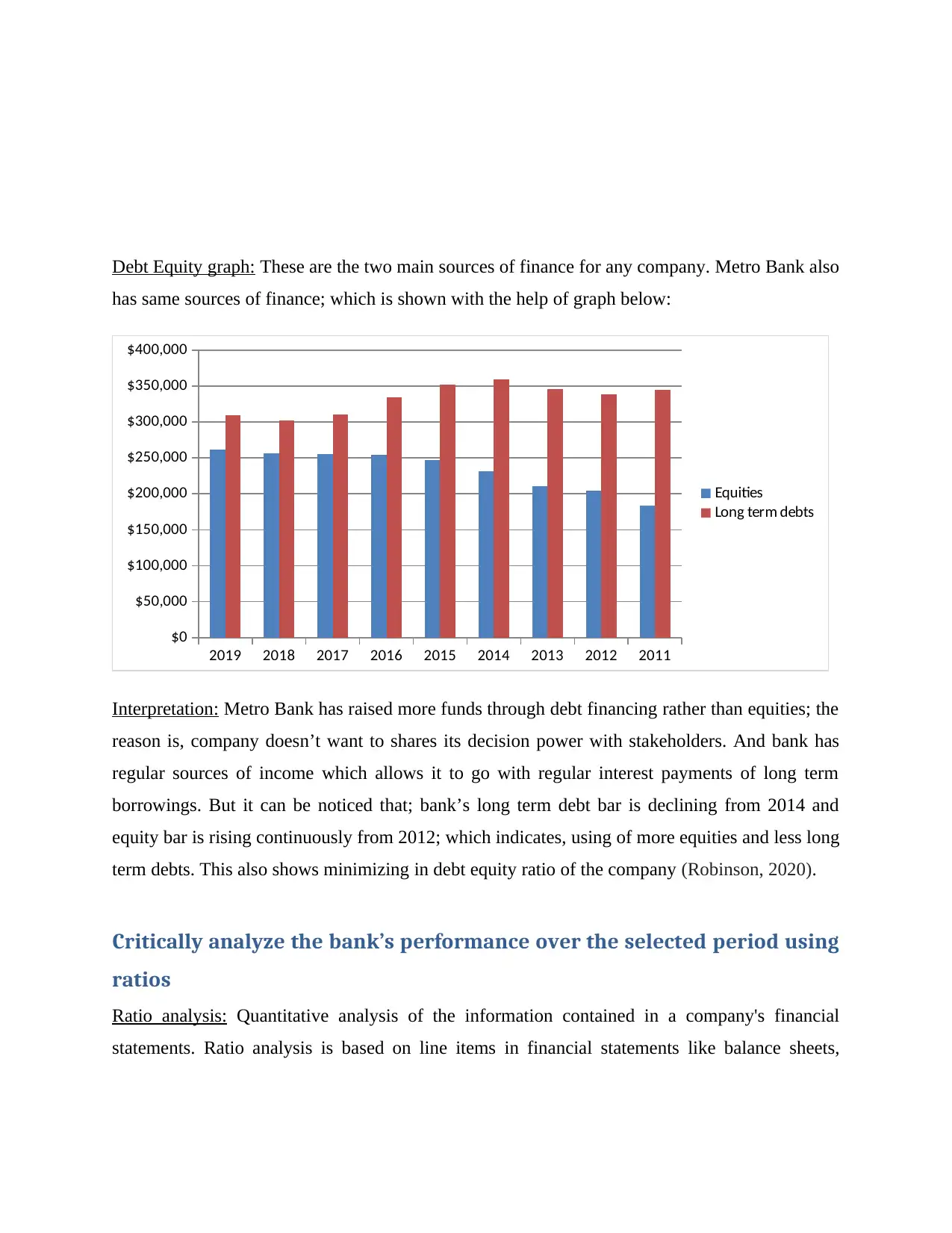
Debt Equity graph: These are the two main sources of finance for any company. Metro Bank also
has same sources of finance; which is shown with the help of graph below:
2019 2018 2017 2016 2015 2014 2013 2012 2011
$0
$50,000
$100,000
$150,000
$200,000
$250,000
$300,000
$350,000
$400,000
Equities
Long term debts
Interpretation: Metro Bank has raised more funds through debt financing rather than equities; the
reason is, company doesn’t want to shares its decision power with stakeholders. And bank has
regular sources of income which allows it to go with regular interest payments of long term
borrowings. But it can be noticed that; bank’s long term debt bar is declining from 2014 and
equity bar is rising continuously from 2012; which indicates, using of more equities and less long
term debts. This also shows minimizing in debt equity ratio of the company (Robinson, 2020).
Critically analyze the bank’s performance over the selected period using
ratios
Ratio analysis: Quantitative analysis of the information contained in a company's financial
statements. Ratio analysis is based on line items in financial statements like balance sheets,
has same sources of finance; which is shown with the help of graph below:
2019 2018 2017 2016 2015 2014 2013 2012 2011
$0
$50,000
$100,000
$150,000
$200,000
$250,000
$300,000
$350,000
$400,000
Equities
Long term debts
Interpretation: Metro Bank has raised more funds through debt financing rather than equities; the
reason is, company doesn’t want to shares its decision power with stakeholders. And bank has
regular sources of income which allows it to go with regular interest payments of long term
borrowings. But it can be noticed that; bank’s long term debt bar is declining from 2014 and
equity bar is rising continuously from 2012; which indicates, using of more equities and less long
term debts. This also shows minimizing in debt equity ratio of the company (Robinson, 2020).
Critically analyze the bank’s performance over the selected period using
ratios
Ratio analysis: Quantitative analysis of the information contained in a company's financial
statements. Ratio analysis is based on line items in financial statements like balance sheets,
⊘ This is a preview!⊘
Do you want full access?
Subscribe today to unlock all pages.

Trusted by 1+ million students worldwide
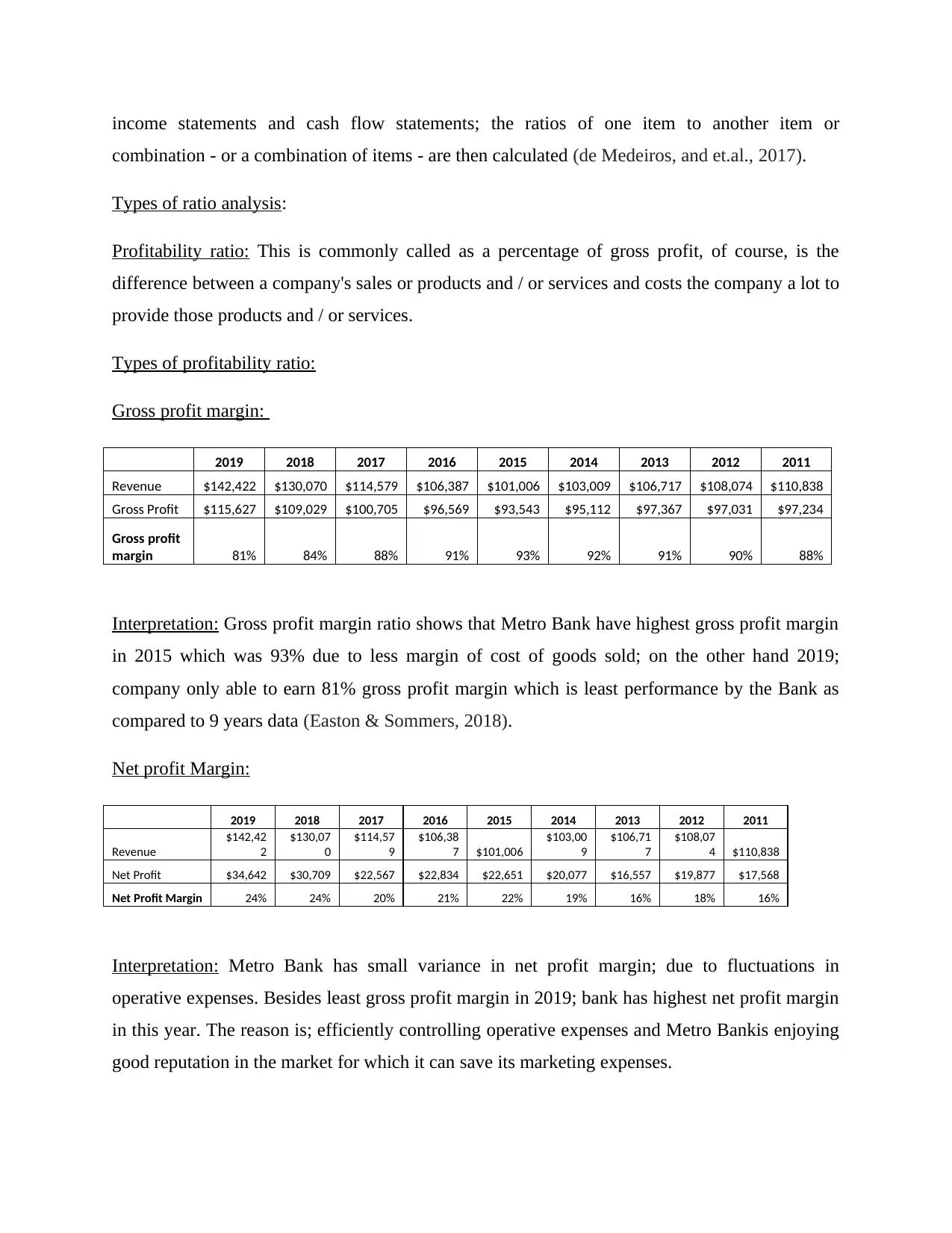
income statements and cash flow statements; the ratios of one item to another item or
combination - or a combination of items - are then calculated (de Medeiros, and et.al., 2017).
Types of ratio analysis:
Profitability ratio: This is commonly called as a percentage of gross profit, of course, is the
difference between a company's sales or products and / or services and costs the company a lot to
provide those products and / or services.
Types of profitability ratio:
Gross profit margin:
2019 2018 2017 2016 2015 2014 2013 2012 2011
Revenue $142,422 $130,070 $114,579 $106,387 $101,006 $103,009 $106,717 $108,074 $110,838
Gross Profit $115,627 $109,029 $100,705 $96,569 $93,543 $95,112 $97,367 $97,031 $97,234
Gross profit
margin 81% 84% 88% 91% 93% 92% 91% 90% 88%
Interpretation: Gross profit margin ratio shows that Metro Bank have highest gross profit margin
in 2015 which was 93% due to less margin of cost of goods sold; on the other hand 2019;
company only able to earn 81% gross profit margin which is least performance by the Bank as
compared to 9 years data (Easton & Sommers, 2018).
Net profit Margin:
2019 2018 2017 2016 2015 2014 2013 2012 2011
Revenue
$142,42
2
$130,07
0
$114,57
9
$106,38
7 $101,006
$103,00
9
$106,71
7
$108,07
4 $110,838
Net Profit $34,642 $30,709 $22,567 $22,834 $22,651 $20,077 $16,557 $19,877 $17,568
Net Profit Margin 24% 24% 20% 21% 22% 19% 16% 18% 16%
Interpretation: Metro Bank has small variance in net profit margin; due to fluctuations in
operative expenses. Besides least gross profit margin in 2019; bank has highest net profit margin
in this year. The reason is; efficiently controlling operative expenses and Metro Bankis enjoying
good reputation in the market for which it can save its marketing expenses.
combination - or a combination of items - are then calculated (de Medeiros, and et.al., 2017).
Types of ratio analysis:
Profitability ratio: This is commonly called as a percentage of gross profit, of course, is the
difference between a company's sales or products and / or services and costs the company a lot to
provide those products and / or services.
Types of profitability ratio:
Gross profit margin:
2019 2018 2017 2016 2015 2014 2013 2012 2011
Revenue $142,422 $130,070 $114,579 $106,387 $101,006 $103,009 $106,717 $108,074 $110,838
Gross Profit $115,627 $109,029 $100,705 $96,569 $93,543 $95,112 $97,367 $97,031 $97,234
Gross profit
margin 81% 84% 88% 91% 93% 92% 91% 90% 88%
Interpretation: Gross profit margin ratio shows that Metro Bank have highest gross profit margin
in 2015 which was 93% due to less margin of cost of goods sold; on the other hand 2019;
company only able to earn 81% gross profit margin which is least performance by the Bank as
compared to 9 years data (Easton & Sommers, 2018).
Net profit Margin:
2019 2018 2017 2016 2015 2014 2013 2012 2011
Revenue
$142,42
2
$130,07
0
$114,57
9
$106,38
7 $101,006
$103,00
9
$106,71
7
$108,07
4 $110,838
Net Profit $34,642 $30,709 $22,567 $22,834 $22,651 $20,077 $16,557 $19,877 $17,568
Net Profit Margin 24% 24% 20% 21% 22% 19% 16% 18% 16%
Interpretation: Metro Bank has small variance in net profit margin; due to fluctuations in
operative expenses. Besides least gross profit margin in 2019; bank has highest net profit margin
in this year. The reason is; efficiently controlling operative expenses and Metro Bankis enjoying
good reputation in the market for which it can save its marketing expenses.
Paraphrase This Document
Need a fresh take? Get an instant paraphrase of this document with our AI Paraphraser
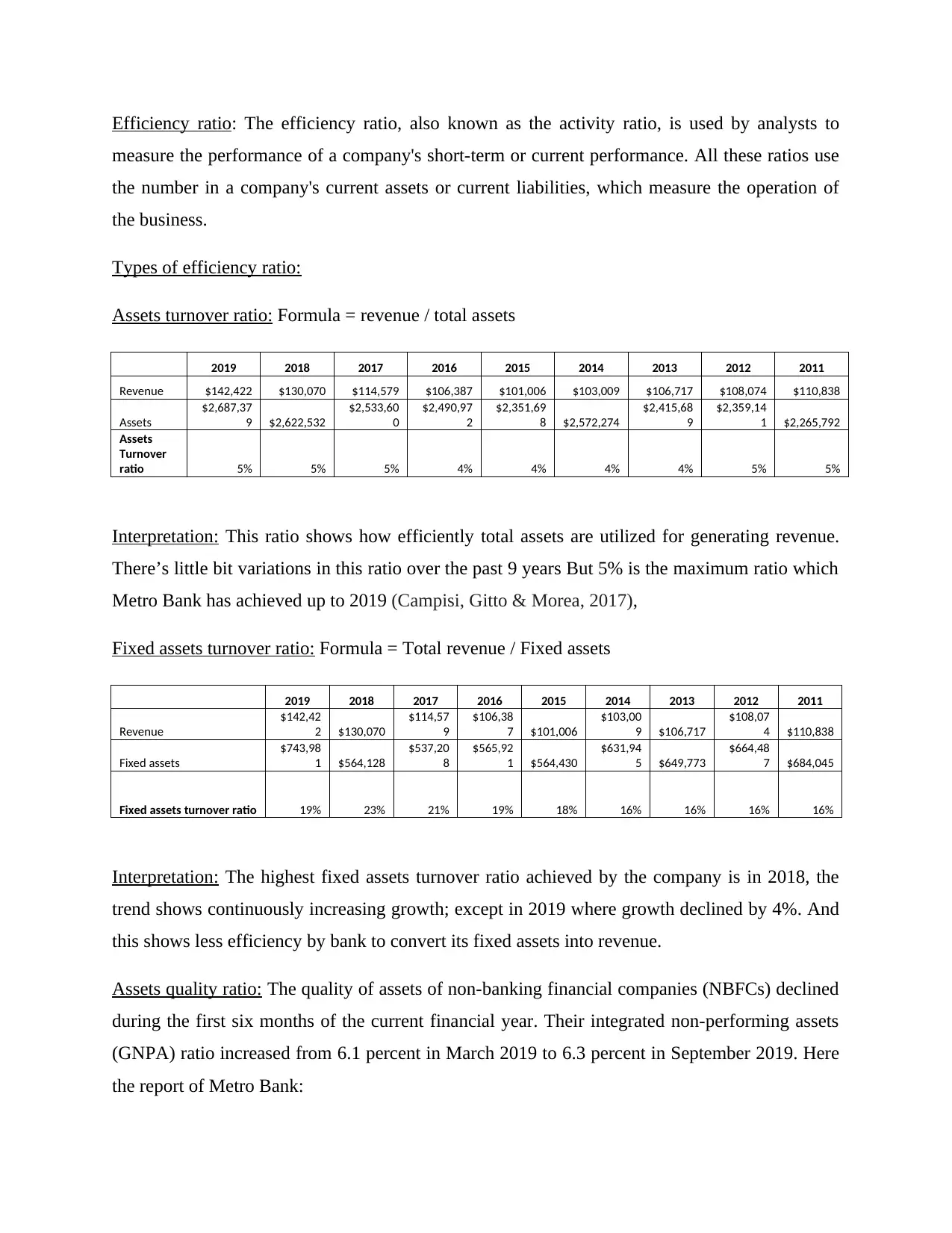
Efficiency ratio: The efficiency ratio, also known as the activity ratio, is used by analysts to
measure the performance of a company's short-term or current performance. All these ratios use
the number in a company's current assets or current liabilities, which measure the operation of
the business.
Types of efficiency ratio:
Assets turnover ratio: Formula = revenue / total assets
2019 2018 2017 2016 2015 2014 2013 2012 2011
Revenue $142,422 $130,070 $114,579 $106,387 $101,006 $103,009 $106,717 $108,074 $110,838
Assets
$2,687,37
9 $2,622,532
$2,533,60
0
$2,490,97
2
$2,351,69
8 $2,572,274
$2,415,68
9
$2,359,14
1 $2,265,792
Assets
Turnover
ratio 5% 5% 5% 4% 4% 4% 4% 5% 5%
Interpretation: This ratio shows how efficiently total assets are utilized for generating revenue.
There’s little bit variations in this ratio over the past 9 years But 5% is the maximum ratio which
Metro Bank has achieved up to 2019 (Campisi, Gitto & Morea, 2017),
Fixed assets turnover ratio: Formula = Total revenue / Fixed assets
2019 2018 2017 2016 2015 2014 2013 2012 2011
Revenue
$142,42
2 $130,070
$114,57
9
$106,38
7 $101,006
$103,00
9 $106,717
$108,07
4 $110,838
Fixed assets
$743,98
1 $564,128
$537,20
8
$565,92
1 $564,430
$631,94
5 $649,773
$664,48
7 $684,045
Fixed assets turnover ratio 19% 23% 21% 19% 18% 16% 16% 16% 16%
Interpretation: The highest fixed assets turnover ratio achieved by the company is in 2018, the
trend shows continuously increasing growth; except in 2019 where growth declined by 4%. And
this shows less efficiency by bank to convert its fixed assets into revenue.
Assets quality ratio: The quality of assets of non-banking financial companies (NBFCs) declined
during the first six months of the current financial year. Their integrated non-performing assets
(GNPA) ratio increased from 6.1 percent in March 2019 to 6.3 percent in September 2019. Here
the report of Metro Bank:
measure the performance of a company's short-term or current performance. All these ratios use
the number in a company's current assets or current liabilities, which measure the operation of
the business.
Types of efficiency ratio:
Assets turnover ratio: Formula = revenue / total assets
2019 2018 2017 2016 2015 2014 2013 2012 2011
Revenue $142,422 $130,070 $114,579 $106,387 $101,006 $103,009 $106,717 $108,074 $110,838
Assets
$2,687,37
9 $2,622,532
$2,533,60
0
$2,490,97
2
$2,351,69
8 $2,572,274
$2,415,68
9
$2,359,14
1 $2,265,792
Assets
Turnover
ratio 5% 5% 5% 4% 4% 4% 4% 5% 5%
Interpretation: This ratio shows how efficiently total assets are utilized for generating revenue.
There’s little bit variations in this ratio over the past 9 years But 5% is the maximum ratio which
Metro Bank has achieved up to 2019 (Campisi, Gitto & Morea, 2017),
Fixed assets turnover ratio: Formula = Total revenue / Fixed assets
2019 2018 2017 2016 2015 2014 2013 2012 2011
Revenue
$142,42
2 $130,070
$114,57
9
$106,38
7 $101,006
$103,00
9 $106,717
$108,07
4 $110,838
Fixed assets
$743,98
1 $564,128
$537,20
8
$565,92
1 $564,430
$631,94
5 $649,773
$664,48
7 $684,045
Fixed assets turnover ratio 19% 23% 21% 19% 18% 16% 16% 16% 16%
Interpretation: The highest fixed assets turnover ratio achieved by the company is in 2018, the
trend shows continuously increasing growth; except in 2019 where growth declined by 4%. And
this shows less efficiency by bank to convert its fixed assets into revenue.
Assets quality ratio: The quality of assets of non-banking financial companies (NBFCs) declined
during the first six months of the current financial year. Their integrated non-performing assets
(GNPA) ratio increased from 6.1 percent in March 2019 to 6.3 percent in September 2019. Here
the report of Metro Bank:
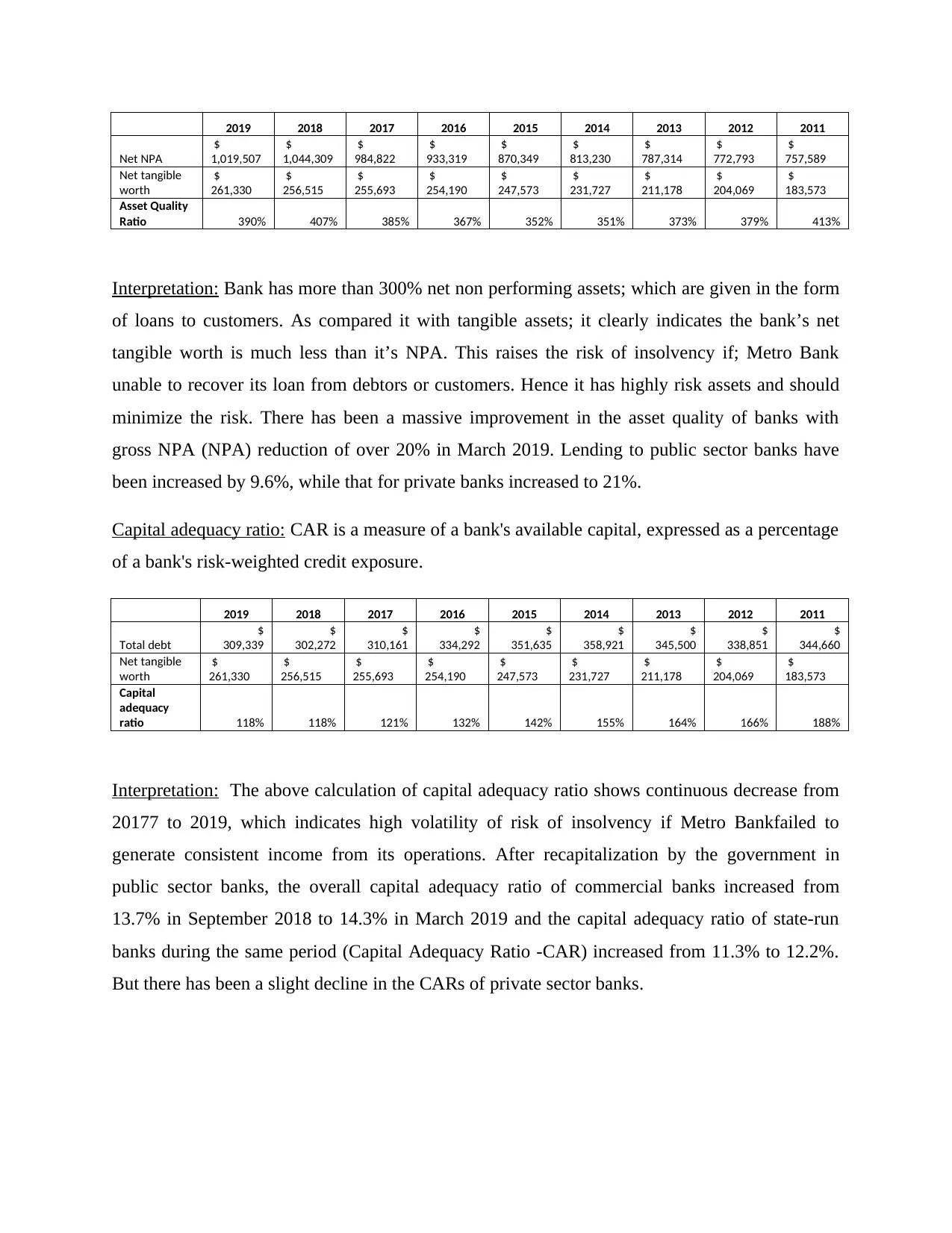
2019 2018 2017 2016 2015 2014 2013 2012 2011
Net NPA
$
1,019,507
$
1,044,309
$
984,822
$
933,319
$
870,349
$
813,230
$
787,314
$
772,793
$
757,589
Net tangible
worth
$
261,330
$
256,515
$
255,693
$
254,190
$
247,573
$
231,727
$
211,178
$
204,069
$
183,573
Asset Quality
Ratio 390% 407% 385% 367% 352% 351% 373% 379% 413%
Interpretation: Bank has more than 300% net non performing assets; which are given in the form
of loans to customers. As compared it with tangible assets; it clearly indicates the bank’s net
tangible worth is much less than it’s NPA. This raises the risk of insolvency if; Metro Bank
unable to recover its loan from debtors or customers. Hence it has highly risk assets and should
minimize the risk. There has been a massive improvement in the asset quality of banks with
gross NPA (NPA) reduction of over 20% in March 2019. Lending to public sector banks have
been increased by 9.6%, while that for private banks increased to 21%.
Capital adequacy ratio: CAR is a measure of a bank's available capital, expressed as a percentage
of a bank's risk-weighted credit exposure.
2019 2018 2017 2016 2015 2014 2013 2012 2011
Total debt
$
309,339
$
302,272
$
310,161
$
334,292
$
351,635
$
358,921
$
345,500
$
338,851
$
344,660
Net tangible
worth
$
261,330
$
256,515
$
255,693
$
254,190
$
247,573
$
231,727
$
211,178
$
204,069
$
183,573
Capital
adequacy
ratio 118% 118% 121% 132% 142% 155% 164% 166% 188%
Interpretation: The above calculation of capital adequacy ratio shows continuous decrease from
20177 to 2019, which indicates high volatility of risk of insolvency if Metro Bankfailed to
generate consistent income from its operations. After recapitalization by the government in
public sector banks, the overall capital adequacy ratio of commercial banks increased from
13.7% in September 2018 to 14.3% in March 2019 and the capital adequacy ratio of state-run
banks during the same period (Capital Adequacy Ratio -CAR) increased from 11.3% to 12.2%.
But there has been a slight decline in the CARs of private sector banks.
Net NPA
$
1,019,507
$
1,044,309
$
984,822
$
933,319
$
870,349
$
813,230
$
787,314
$
772,793
$
757,589
Net tangible
worth
$
261,330
$
256,515
$
255,693
$
254,190
$
247,573
$
231,727
$
211,178
$
204,069
$
183,573
Asset Quality
Ratio 390% 407% 385% 367% 352% 351% 373% 379% 413%
Interpretation: Bank has more than 300% net non performing assets; which are given in the form
of loans to customers. As compared it with tangible assets; it clearly indicates the bank’s net
tangible worth is much less than it’s NPA. This raises the risk of insolvency if; Metro Bank
unable to recover its loan from debtors or customers. Hence it has highly risk assets and should
minimize the risk. There has been a massive improvement in the asset quality of banks with
gross NPA (NPA) reduction of over 20% in March 2019. Lending to public sector banks have
been increased by 9.6%, while that for private banks increased to 21%.
Capital adequacy ratio: CAR is a measure of a bank's available capital, expressed as a percentage
of a bank's risk-weighted credit exposure.
2019 2018 2017 2016 2015 2014 2013 2012 2011
Total debt
$
309,339
$
302,272
$
310,161
$
334,292
$
351,635
$
358,921
$
345,500
$
338,851
$
344,660
Net tangible
worth
$
261,330
$
256,515
$
255,693
$
254,190
$
247,573
$
231,727
$
211,178
$
204,069
$
183,573
Capital
adequacy
ratio 118% 118% 121% 132% 142% 155% 164% 166% 188%
Interpretation: The above calculation of capital adequacy ratio shows continuous decrease from
20177 to 2019, which indicates high volatility of risk of insolvency if Metro Bankfailed to
generate consistent income from its operations. After recapitalization by the government in
public sector banks, the overall capital adequacy ratio of commercial banks increased from
13.7% in September 2018 to 14.3% in March 2019 and the capital adequacy ratio of state-run
banks during the same period (Capital Adequacy Ratio -CAR) increased from 11.3% to 12.2%.
But there has been a slight decline in the CARs of private sector banks.
⊘ This is a preview!⊘
Do you want full access?
Subscribe today to unlock all pages.

Trusted by 1+ million students worldwide

Evaluate how the banking sector changes have impacted Metro Bank
performance
Banking sector has track many changes over the period of time in terms of technology, way of
operations and delivery of services. Some of these changes have been discussed below:
a. Changes in bank regulation
The Federal Reserve System (also known as the Federal Reserve or simply the Fed) is the central
banking system of the United States which regulates all public and commercial banks in New
York and other states of America. The US Central Bank Federal Reserve has not made any
changes in interest rates. The central bank committee decided to keep the interest rates at 1.25-
1.5 per cent after the meeting. Emerging markets around the world have breathed a sigh of relief.
Impact on Metro Bank: Bank interest rates is expected to be increased in future; which will
provide more opportunity to banks to raise its loan amount but at the same time; its liability to
pay more interest on savings by general public will also increase. This will affect overall net
profit margin of the company in next financial year 2020 (Metro Bank Balance Sheet 2005-2020
JPM, 2020).
b. Increase impact of FinTech developments on banking business
FinTech refers to the integration of technology into financial services; it is also knows as
digitalization of banking services. The review proposes that public sector banks need to embrace
FinTech, which is revolutionizing the global financial landscape. FinTech has rapidly changed
the way information is refined by banks.
Banks always provide transaction intermediaries necessary to provide humanitarian assistance by
recording in "centralized" databases. With years of technological innovation, the banking
industry is improving its financial processes and products, and is now slowly adapting to digital
transformation and financial technology models. However, there is a technology that is not only
digital, fast and secure, but also a "distributed" database that records the visible transactions of
all stakeholders involved in its network across international borders, which means providing full
transparency capability do. To this end, banks may no longer need to help deliver business
(Yarbro & Mehlenbeck, 2016).
performance
Banking sector has track many changes over the period of time in terms of technology, way of
operations and delivery of services. Some of these changes have been discussed below:
a. Changes in bank regulation
The Federal Reserve System (also known as the Federal Reserve or simply the Fed) is the central
banking system of the United States which regulates all public and commercial banks in New
York and other states of America. The US Central Bank Federal Reserve has not made any
changes in interest rates. The central bank committee decided to keep the interest rates at 1.25-
1.5 per cent after the meeting. Emerging markets around the world have breathed a sigh of relief.
Impact on Metro Bank: Bank interest rates is expected to be increased in future; which will
provide more opportunity to banks to raise its loan amount but at the same time; its liability to
pay more interest on savings by general public will also increase. This will affect overall net
profit margin of the company in next financial year 2020 (Metro Bank Balance Sheet 2005-2020
JPM, 2020).
b. Increase impact of FinTech developments on banking business
FinTech refers to the integration of technology into financial services; it is also knows as
digitalization of banking services. The review proposes that public sector banks need to embrace
FinTech, which is revolutionizing the global financial landscape. FinTech has rapidly changed
the way information is refined by banks.
Banks always provide transaction intermediaries necessary to provide humanitarian assistance by
recording in "centralized" databases. With years of technological innovation, the banking
industry is improving its financial processes and products, and is now slowly adapting to digital
transformation and financial technology models. However, there is a technology that is not only
digital, fast and secure, but also a "distributed" database that records the visible transactions of
all stakeholders involved in its network across international borders, which means providing full
transparency capability do. To this end, banks may no longer need to help deliver business
(Yarbro & Mehlenbeck, 2016).
Paraphrase This Document
Need a fresh take? Get an instant paraphrase of this document with our AI Paraphraser

The block chain has provided the right kind of support, at the right time, at the right time, with
the opportunity to make the necessary trust changes between stakeholders: the beginning of a
new non-mediated era seems to be the humanitarian future of the system.
c. Consolidation in the banking sector of the particular country
In the future, technology will determine the modalities of banking. This includes huge data,
cloud computing, smart phones and other similar inventions. Consolidation within American
industry has led to a very high 50 percent inside bank amount and to bring about sweetness in
relationships during the preceding 20 years. Our paper has reviewed important changes within
the business in this period. The association redefines the macroeconomic forces behind design
and the microeconomics etiquette of thinking; Reviews the results of actual research on mixing
what has been impacted on things like banking disputes, efficiency, productivity, speculative
connectors and availability and evaluation of banking organizations. And theories on how
recurring patterns of progress can influence the functioning of force business structure. As the
21st century expands, we find that some of the forces that drove the design of the union inside
the past no longer appear significant or are reduced to a very small extent (Smith, Betts & Smith,
2018).
By concretizing this data in our estimation, we imagine that money-related businesses may
experience a slight to coordinate decline inside the volume of relationships over the course of
five to 10 years.
d. Other issues occur changes in the global banking markets
The worldwide budgetary emergency prompted a reintegration of the advantages and dangers of
the account - including administrations related to universal money - which many viewers accept
were too large and overly confusing and whose items, e.g. However, complex investigations and
subsidiaries appeared to offer very little value although several risks have arisen.
Fringe has grown rapidly over the course of two years, with banking coming back around the
world. In the early three months of 2008, the total remote bank lending fell drastically in the
wake of the crimping. The decay was particularly large in direct cross-fringe advances; Debt
through external members is continuously increasing. This patronage was largely driven by
showcase powers, as their wealth reports under promoted banks were reduced. Be that as it may,
the opportunity to make the necessary trust changes between stakeholders: the beginning of a
new non-mediated era seems to be the humanitarian future of the system.
c. Consolidation in the banking sector of the particular country
In the future, technology will determine the modalities of banking. This includes huge data,
cloud computing, smart phones and other similar inventions. Consolidation within American
industry has led to a very high 50 percent inside bank amount and to bring about sweetness in
relationships during the preceding 20 years. Our paper has reviewed important changes within
the business in this period. The association redefines the macroeconomic forces behind design
and the microeconomics etiquette of thinking; Reviews the results of actual research on mixing
what has been impacted on things like banking disputes, efficiency, productivity, speculative
connectors and availability and evaluation of banking organizations. And theories on how
recurring patterns of progress can influence the functioning of force business structure. As the
21st century expands, we find that some of the forces that drove the design of the union inside
the past no longer appear significant or are reduced to a very small extent (Smith, Betts & Smith,
2018).
By concretizing this data in our estimation, we imagine that money-related businesses may
experience a slight to coordinate decline inside the volume of relationships over the course of
five to 10 years.
d. Other issues occur changes in the global banking markets
The worldwide budgetary emergency prompted a reintegration of the advantages and dangers of
the account - including administrations related to universal money - which many viewers accept
were too large and overly confusing and whose items, e.g. However, complex investigations and
subsidiaries appeared to offer very little value although several risks have arisen.
Fringe has grown rapidly over the course of two years, with banking coming back around the
world. In the early three months of 2008, the total remote bank lending fell drastically in the
wake of the crimping. The decay was particularly large in direct cross-fringe advances; Debt
through external members is continuously increasing. This patronage was largely driven by
showcase powers, as their wealth reports under promoted banks were reduced. Be that as it may,
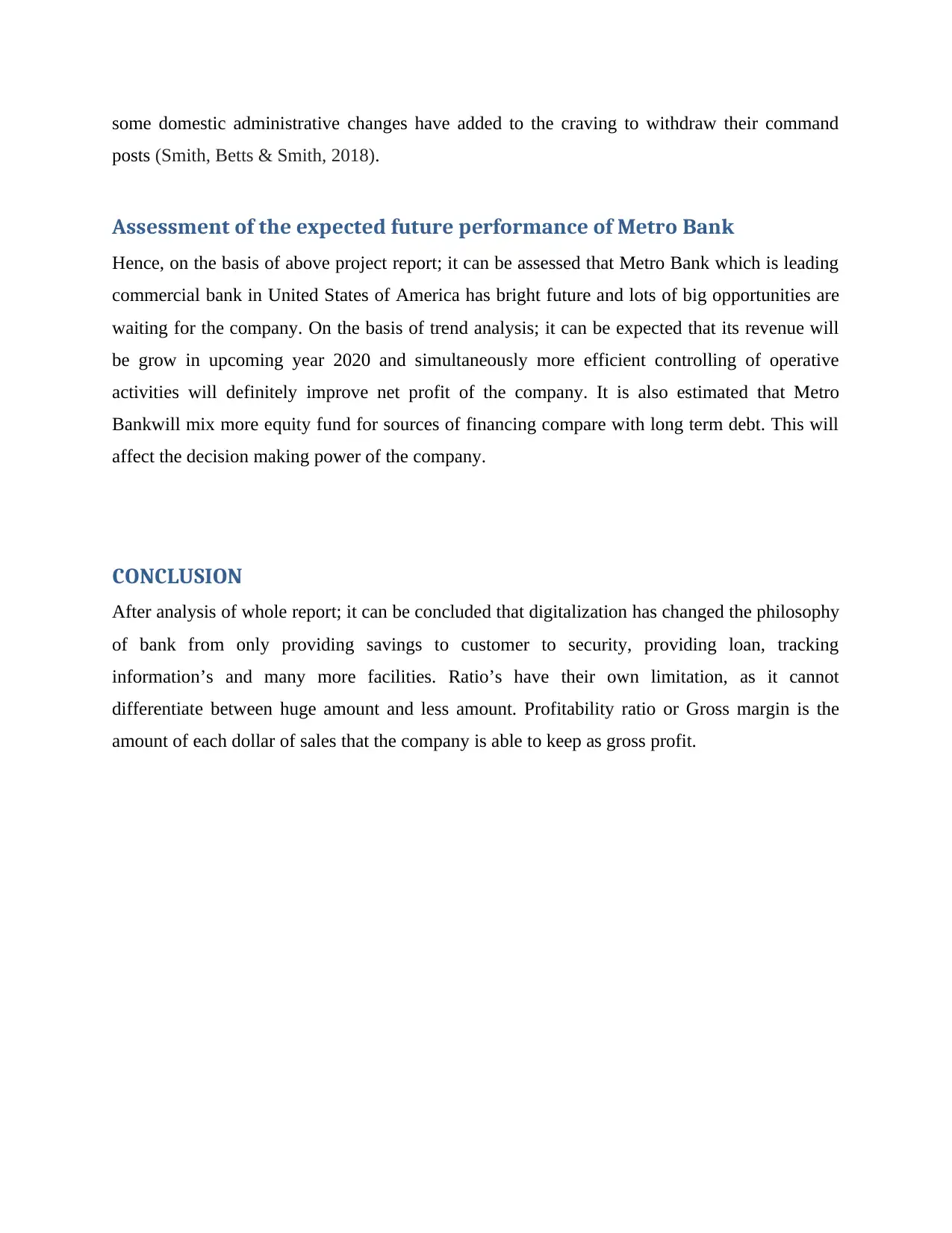
some domestic administrative changes have added to the craving to withdraw their command
posts (Smith, Betts & Smith, 2018).
Assessment of the expected future performance of Metro Bank
Hence, on the basis of above project report; it can be assessed that Metro Bank which is leading
commercial bank in United States of America has bright future and lots of big opportunities are
waiting for the company. On the basis of trend analysis; it can be expected that its revenue will
be grow in upcoming year 2020 and simultaneously more efficient controlling of operative
activities will definitely improve net profit of the company. It is also estimated that Metro
Bankwill mix more equity fund for sources of financing compare with long term debt. This will
affect the decision making power of the company.
CONCLUSION
After analysis of whole report; it can be concluded that digitalization has changed the philosophy
of bank from only providing savings to customer to security, providing loan, tracking
information’s and many more facilities. Ratio’s have their own limitation, as it cannot
differentiate between huge amount and less amount. Profitability ratio or Gross margin is the
amount of each dollar of sales that the company is able to keep as gross profit.
posts (Smith, Betts & Smith, 2018).
Assessment of the expected future performance of Metro Bank
Hence, on the basis of above project report; it can be assessed that Metro Bank which is leading
commercial bank in United States of America has bright future and lots of big opportunities are
waiting for the company. On the basis of trend analysis; it can be expected that its revenue will
be grow in upcoming year 2020 and simultaneously more efficient controlling of operative
activities will definitely improve net profit of the company. It is also estimated that Metro
Bankwill mix more equity fund for sources of financing compare with long term debt. This will
affect the decision making power of the company.
CONCLUSION
After analysis of whole report; it can be concluded that digitalization has changed the philosophy
of bank from only providing savings to customer to security, providing loan, tracking
information’s and many more facilities. Ratio’s have their own limitation, as it cannot
differentiate between huge amount and less amount. Profitability ratio or Gross margin is the
amount of each dollar of sales that the company is able to keep as gross profit.
⊘ This is a preview!⊘
Do you want full access?
Subscribe today to unlock all pages.

Trusted by 1+ million students worldwide
1 out of 14
Related Documents
Your All-in-One AI-Powered Toolkit for Academic Success.
+13062052269
info@desklib.com
Available 24*7 on WhatsApp / Email
![[object Object]](/_next/static/media/star-bottom.7253800d.svg)
Unlock your academic potential
Copyright © 2020–2025 A2Z Services. All Rights Reserved. Developed and managed by ZUCOL.





